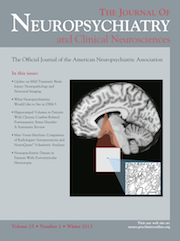Functional Auditory Hallucinations in a Case of Serotonin Syndrome
To the Editor: Serotonin syndrome is a potentially life-threatening condition that requires heightened clinical awareness for recognition and prompt treatment.1 It usually results from increased brainstem serotonin activity due to overdose or combinations of medications or drugs of abuse with serotonergic activity.2 The clinical features of the serotonin syndrome include alterations in mental status and behavior, hyperthermia, along with signs and symptoms of neurological, gastrointestinal, and autonomic nervous system dysfunction.1 Auditory and visual hallucinations are common in this condition and are included in Sternbach’s diagnostic criteria.3 However, a PubMed search supplemented with manual search did not reveal any previous reports of functional auditory hallucinations in this condition. This report describes a case of serotonin syndrome that presented with florid functional auditory hallucinations in the absence of any true auditory hallucinations.
Case Report
“Mr. A,” a 35-year-old man diagnosed with obsessive-compulsive disorder for 13 years with predominant obsessions of contamination and washing compulsions, was receiving a combination of sertraline 200 mg/day, clomipramine 225 mg/day, lithium carbonate 800 mg/day, and risperidone 2 mg/day. He experienced inadequate symptomatic improvement despite being on this regime for more than 8 weeks, and he was almost housebound. Disappointed, he decided to try a higher dosage of medications, and increased the dose of sertraline to 400 mg/day on his own. After 2 weeks, he presented to us with complaints of hearing voices, difficulty in walking, and occasional twitching of face and body. There was no history of past medical illness or substance use. Family history and personal history was unremarkable.
Physical examination revealed increased sweating, blood pressure of 130/90 mm Hg, coarse tremors of extremities, occasional myoclonic jerks, and ataxic gait. On mental status examination, he was conscious, oriented, and had florid functional auditory hallucinations. He reported hearing music from a fan or tap water along with their sounds and was highly distressed. The findings from history and physical examination met Sternbach’s criteria3 for serotonin syndrome. The dose of sertraline was reduced to 200 mg/day, and the symptoms and signs of serotonin syndrome resolved within 3 days, including complete disappearance of functional auditory hallucinations.
Discussion
This patient’s florid functional hallucinations apparently resulted from serotonin toxicity, as he had other known symptoms and signs of the condition, like coarse tremors, ataxic gait, and hypertension. The fact that the symptoms promptly resolved on reduction in sertraline dose also supports the diagnosis. Moderate overdoses of specific serotonin reuptake inhibitors (SSRIs), up to 30 times the common daily dose, are reported to be associated with minor or no symptoms.4 This patient apparently developed serotonin syndrome because he was also taking other serotonergic agents, such as clomipramine and lithium. In a large study involving 2,222 patients, mild serotonin toxicity occurred in only 15% of SSRI-alone overdoses, whereas severe and potentially fatal serotonin toxicity occurred in 50% of cases in those with SSRIs along with other serotonergic medications.5
Functional hallucinations are defined as those that occur when a patient simultaneously perceives the stimulus as well as the hallucination.6 In our patient, musical hallucinations occurred along with the sounds of tap-water or fan, and in the absence of such stimuli, there were no hallucinations. The true hallucinations probably originate from abnormal activation of auditory cortex, and it has been suggested that in functional hallucination there may be a misinterpretation of the neural encoding of natural-sound object and location characteristics that leads to the false perception that retains certain acoustic features of the original signal.7 Compared with true hallucinations, functional hallucinations are usually given little diagnostic importance.6 However, this case illustrates that serotonin toxicity may present only with functional hallucinations, without any true hallucinations. Therefore, functional auditory hallucinations may have equal diagnostic importance as true hallucinations during serotonin toxicity.
1 : The serotonin syndrome. N Engl J Med 2005; 352:1112–1120Crossref, Medline, Google Scholar
2 : Prevention, recognition, and management of serotonin syndrome. Am Fam Physician 2010; 81:1139–1142Medline, Google Scholar
3 : The serotonin syndrome. Am J Psychiatry 1991; 148:705–713Crossref, Medline, Google Scholar
4 : SSRI safety in overdose. J Clin Psychiatry 1998; 59(Suppl 15):42–48Medline, Google Scholar
5 : Serotonin syndrome, in Adverse Syndromes and Psychiatric Drugs. Edited by Haddad PDursun SDeakin B. Oxford, England, Oxford University Press, 2004, pp 37–49Crossref, Google Scholar
6 Casey PKelly B (eds): Fish’s Clinical Psychopathology: Signs and Symptoms in Psychiatry, 3rd Edition. London, UK, The Royal College of Psychiatrists, 2007Google Scholar
7 : Characteristics of functional auditory hallucinations. Am J Psychiatry 2004; 161:923Crossref, Medline, Google Scholar



